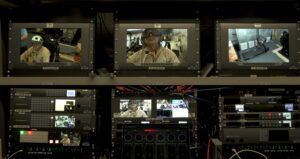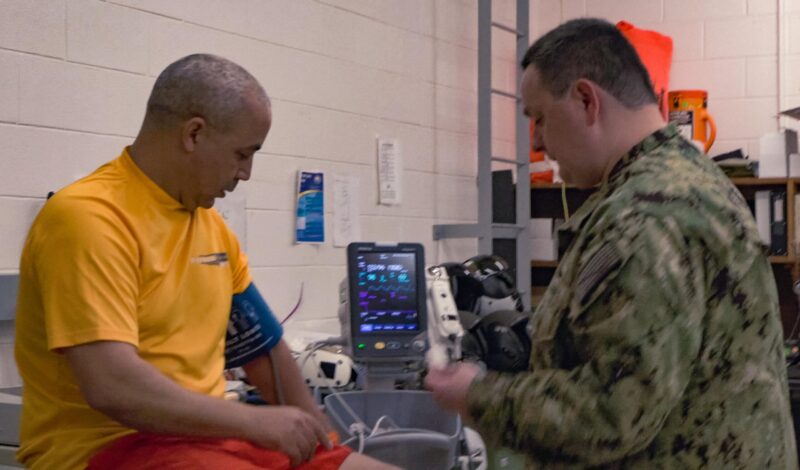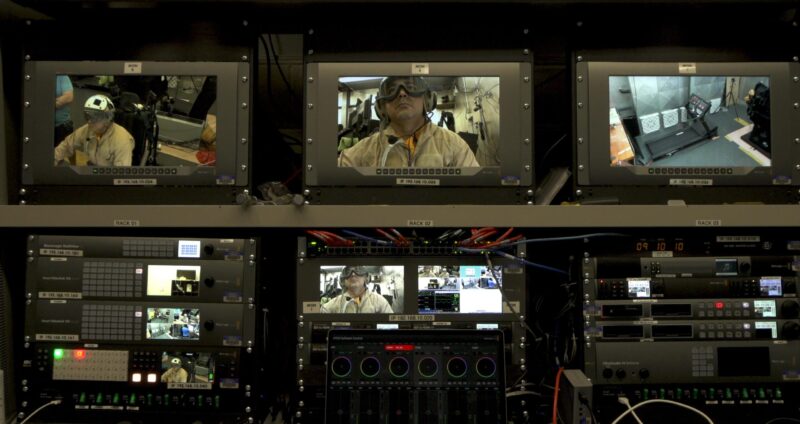
Humans systems engineering technicians at the Naval Air Warfare Center Aircraft Division monitor subjects undergoing tests in a temperature-controlled environment supporting engineering efforts aiming to enhance aeromedical technology for aircrew across naval aviation. (U.S. Navy photo by Charles Freeman)
The Naval Air Warfare Center Aircraft Division (NAWCAD) is advancing its human systems technology by combining best practices from the medical and engineering communities.
The warfare center recently stood up the Aeromedical Monitoring and Analysis branch comprised of licensed medical military officers bridging their perspective with engineering disciplines to improve operational capabilities like night vision technology, hearing protection, mission planning software, and more.
“Medicine and engineering seldom wholly come together,” said NAWCAD Aeromedical Monitoring and Analysis branch head Cmdr. Matthew Doubrava, a Navy Flight Surgeon board certified in Aerospace Medicine and Occupational Medicine. “Our team of biomedical scientists looks forward to bringing human oriented science and a medical perspective to enhance our Navy’s advanced technology.”
The uniformed medical specialists have a broad range of academic expertise including aerospace and occupation medicine, optometry and vision science, audiology, research and aviation physiology, and experimental psychology. With these skillsets, they will work directly alongside NAWCAD engineers, testers, and aviators to enhance their research, development, tests, and evaluation to advance aerospace technology. Adding this expertise will help create technology more relevant to human capability, and fill knowledge gaps where technical professionals typically hold little experience.
“The Navy’s challenge with physiological episodes showed us how critically important a medical perspective can be,” said Doubrava. “We’re working to stay ahead of the curve – what is the next ‘physiological episode’ on the horizon and how can we prevent it?”
NAWCAD’s lineup of clinical scientists completed health care professional and graduate school, and entered the Navy to receive specialized training as aeromedical and research professionals. Most attended the six-month Aeromedical Officer Course that consists of a specialized flight school syllabus and clinical training in Pensacola, Florida. As an aeromedical officer, they hold a Navy aeronautical rating that requires a monthly minimum of aircrew flight time making them uniquely qualified as aeromedical professionals. While their primary mission is medical research, they are required to accrue flight time with fleet aviators for continued understanding of naval aviation’s evolving systems.
NAWCAD advances capability and operational readiness for naval aviation and our warfighters. The warfare center is where naval aviation takes flight through research, development, test, evaluation, and sustainment of both fielded and not-yet fielded naval platforms and technologies that ensure America’s Sailors and Marines always go into conflict with significant advantage. With sites in Patuxent River, Maryland, Lakehurst, New Jersey, and Orlando, Florida, the command is the Navy’s largest warfare center with a diverse force of military, civilians, and contractors building the Navy of today, the Navy of tomorrow, and the Navy after next.

Lt. Cmdr. Kyle Shepard, a Navy audiologist with the Naval Air Warfare Center Aircraft Division’s first-ever aeromedical branch, conducts a series of physical exams with another sailor ahead of human systems engineering tests at Naval Air Station Patuxent River. The tests will support human systems engineering efforts aiming to enhance naval aviation technology. (U.S. Navy photo by Charles Freeman)

Humans systems engineering technicians at the Naval Air Warfare Center Aircraft Division monitor subjects undergoing tests in a temperature-controlled environment supporting engineering efforts aiming to enhance aeromedical technology for aircrew across naval aviation. (U.S. Navy photo by Charles Freeman)


